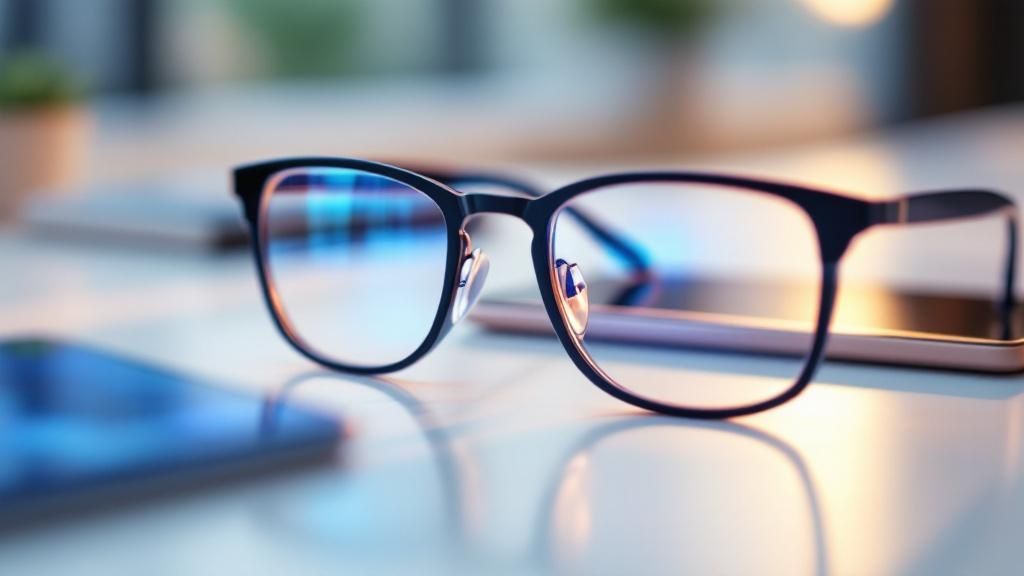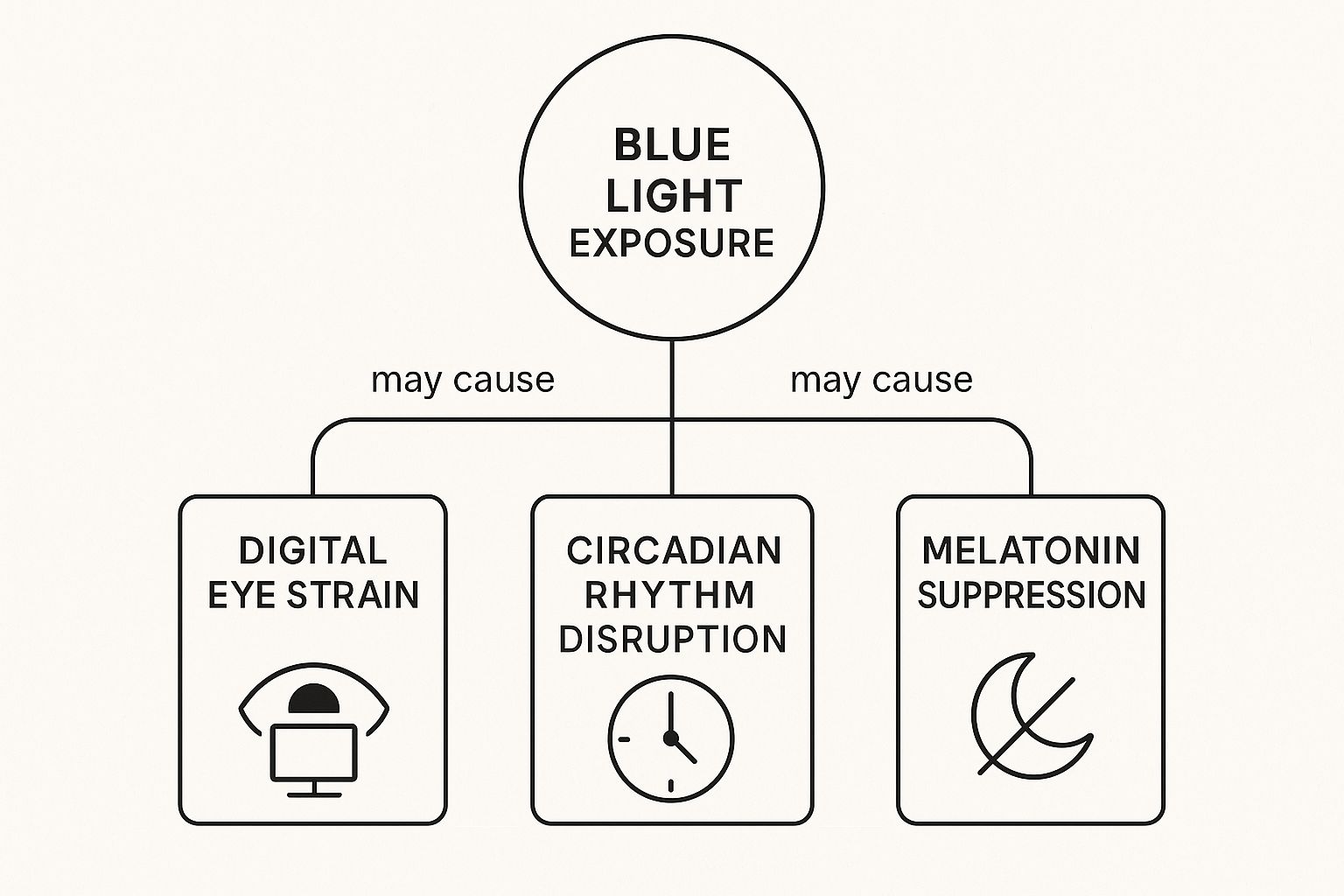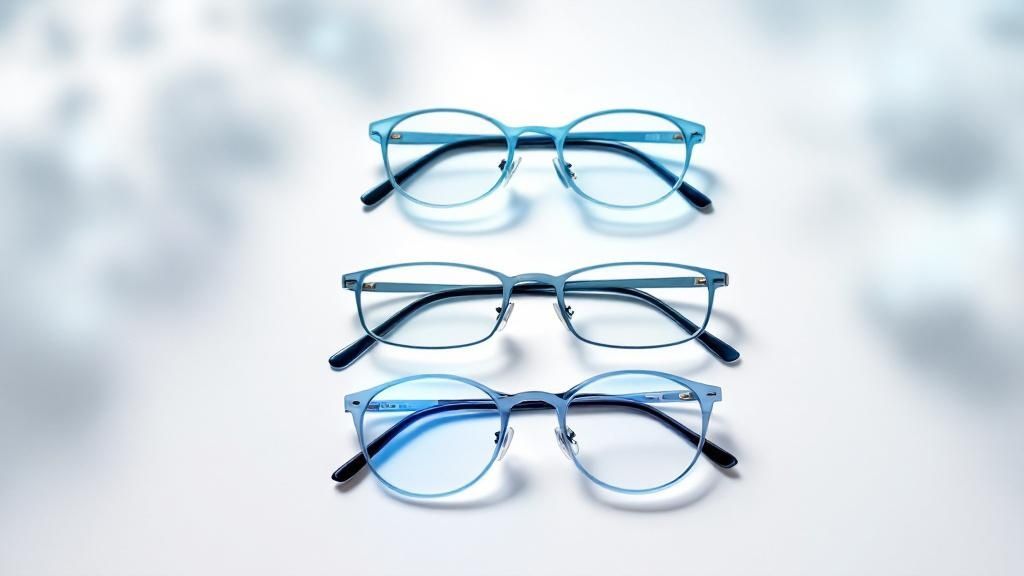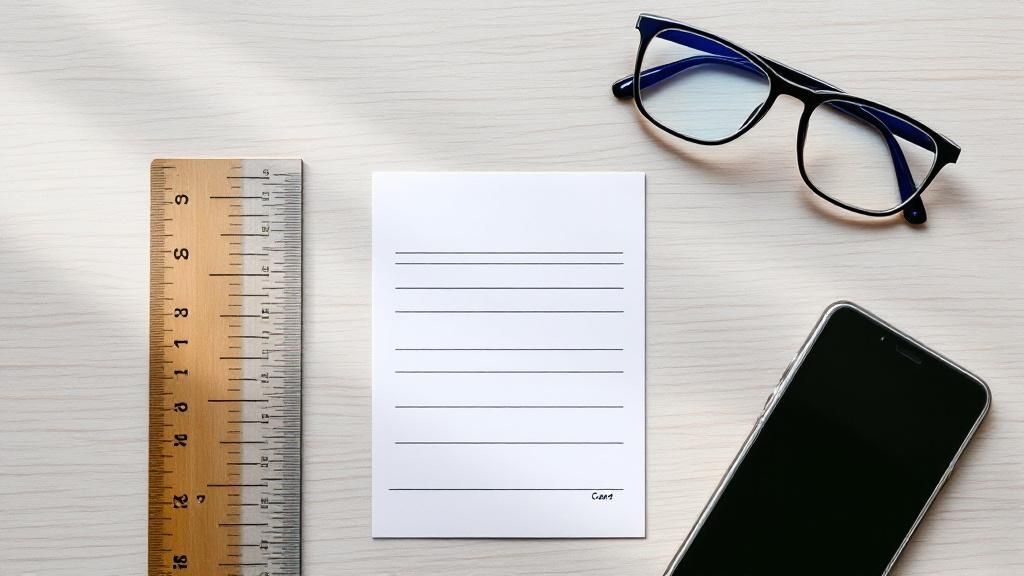
Guide to Prescription Glasses That Block Blue Light
If you spend a good chunk of your day staring at a screen, you know the feeling: the dull headache, the tired, gritty eyes, and the trouble winding down at night. It’s a modern problem, and prescription glasses that block blue light are a fantastic solution. They correct your vision while also filtering out the harsh, high-energy light from all our devices.
Your Guide to Healthier Vision
Think of this as your personal consultation on making a smart investment in your eye health and daily comfort. We're diving deep into these specialized glasses that merge vision correction with protective filtering tech, designed specifically for the challenges of our screen-heavy lives.
We’ll break down the science behind blue light, get into how too much of it can throw your body off-kilter, and explore the different lens technologies you can choose from.
Why This Matters Now More Than Ever
The need for a good blue light solution has absolutely skyrocketed right alongside our screen time. This isn't some niche gadget anymore; it’s become a go-to wellness tool for anyone glued to a digital device, from office workers to students.
The market is showing it, too. Globally, the blue light blocking glasses market was valued at $2.7 billion in 2023 and is expected to hit $5.2 billion by 2032. That massive jump is no accident—it lines up with the growing reports of digital eye strain tied directly to our phones and computers. You can see more on the blue light glasses market growth on businessresearchinsights.com.
The real win here is twofold: you get the crystal-clear vision you need from your prescription, while also dialing down the visual stress that causes so much discomfort and fatigue.
Creating a Comfortable Digital Environment
While the right glasses are a huge step, they're just one piece of the puzzle. The environment where you use your screens also plays a massive part in how your eyes feel. For example, having the right ambient light keeps your eyes from constantly struggling to adjust between a super-bright screen and a dark room.
A well-lit and comfortable workspace is just as crucial as good eyewear for fighting off digital eye strain. It’s worth learning about optimizing your home office lighting for better eye comfort to build a complete defense against visual fatigue.
This guide will give you a clear roadmap to choosing the perfect pair of prescription blue light glasses, hitting on all the key points:
- Understanding Blue Light: What it is, and how it really affects your eyes and sleep.
- Lens Technology: A look at how the different filtering methods actually work.
- Protection Levels: How to pick the right filter strength for your daily routine.
- Frame Selection: Making sure your new glasses are not just effective but also comfortable enough to wear all day.
Understanding Blue Light and Its Impact on Your Eyes

To really get why prescription glasses that block blue light are so helpful, we first need to talk about what blue light actually is. Think of all visible light as a rainbow. On one end, you have red light with its long, lazy, low-energy waves. On the complete opposite end, you’ll find blue light, which has a much shorter wavelength and packs a much bigger energy punch.
It's a bit like waves at the beach. Long, rolling waves are pretty gentle, but short, choppy waves crash against the shore with more force. Blue light acts like those powerful, choppy waves, and our eyes are the shoreline taking the hit.
The sun is our planet's biggest source of this high-energy visible (HEV) light. And in nature, that's a good thing! Natural blue light is crucial for regulating our circadian rhythm—that's the body’s internal 24-hour clock that signals when it's time to be alert and when it's time to wind down.
The real issue comes from our constant, up-close-and-personal exposure to artificial blue light. Our modern world is absolutely drenched in it, with screens beaming it straight into our eyes all day and often all night.
The Digital Deluge of Blue Light
We are literally surrounded by devices that emit this intense light, often for hours at a time. This creates a kind of overexposure our eyes simply weren't built to handle. The main culprits are probably sitting within arm's reach right now:
- Smartphones and Tablets: We hold them so close to our faces, delivering a super-concentrated dose of blue light.
- Computer Monitors and Laptops: For many, these are the centerpiece of the workday and a massive source of prolonged exposure.
- Televisions: Modern LED and QLED screens are especially known for their bright, blue-light-intensive displays.
- LED and Fluorescent Lighting: Even the energy-efficient lightbulbs in our homes and offices add to our total daily dose.
This nonstop bombardment is a direct cause of what's known as digital eye strain, or computer vision syndrome. If you've ever ended a long workday or a late-night scrolling session with tired, achy eyes, you know exactly what this feels like.
Digital eye strain isn’t just a passing irritation; it’s your body's physical reaction to all that visual stress. By filtering out the harshest wavelengths of light, blue light blocking lenses help ease the muscular effort your eyes have to make just to stay focused on a screen.
How Overexposure Affects Your Eyes and Brain
The fallout from too much blue light is a one-two punch that hits your immediate comfort and your long-term wellness. First, there's the direct physical discomfort. Your eye muscles have to work overtime to process this harsh light, which can lead to common complaints like dry, irritated eyes, blurry vision, and nagging tension headaches.
Second, and maybe even more importantly, it messes with your sleep. When you're staring at a screen late into the evening, you're basically sending your brain a bright, sunny signal that says, "It's the middle of the day!" Research shows this exposure suppresses the production of melatonin, the key hormone that tells your body it’s time to sleep.
The result? You have a tougher time falling asleep, and the sleep you do get isn't as restorative. Over time, this can snowball into chronic fatigue and take a toll on your overall health. To see the science for yourself, you can dig into the extensive research and studies on blue light.
Ultimately, wearing prescription glasses that block blue light is a simple, powerful way to take back your focus during the day and protect your precious rest at night.
How Blue Light Filtering Lenses Actually Work
Now that we know why we should be mindful of blue light, let’s get into the nitty-gritty of how prescription glasses that block blue light actually do their job. It's not a single trick; lens makers use two main methods to shield your eyes, and each one takes a completely different approach to stopping that high-energy light.
You can think of it like defending a castle from an attack. One option is to build a massive, reflective shield on the outer wall to bounce projectiles away. The other is to make the walls themselves out of a super-dense material that just soaks up the impact. Blue light lenses work in a very similar way.
The infographic below really drives home why this technology is so important, showing the chain reaction that unmanaged blue light can kick off.

As you can see, it's not just about tired eyes. That constant exposure can mess with your body's melatonin production, throw your sleep-wake cycle out of whack, and ultimately sap your energy day after day.
The Reflective Shield Approach
The first and most common method you'll find is a special filtering coating applied right onto the surface of the prescription lenses. This ultra-thin layer is engineered to be a selective bouncer, targeting and reflecting away specific wavelengths of blue-violet light.
It's smart technology. Most of the "good" light needed for crisp, clear vision gets a free pass, while a big chunk of the "bad" high-energy blue light is turned away before it ever reaches your eye. The biggest plus here is that these lenses look almost perfectly clear. You might only notice a faint blue or purple reflection when the light hits them just right.
This makes coated lenses a fantastic choice for anyone whose job depends on accurate color perception—think graphic designers, photographers, or video editors. They cause very little color distortion, making them perfect for all-day wear in an office setting.
The Absorption Sponge Method
The second strategy takes a different tack. Instead of adding a coating, manufacturers infuse the lens material itself with special light-absorbing compounds during the creation process. These lenses don't reflect the light; they act more like a sponge, soaking up the high-energy blue light as it tries to pass through.
This approach is often more powerful, blocking a higher percentage of the blue light spectrum. The trade-off? These lenses almost always have a noticeable tint, which can be anything from a pale, barely-there yellow to a much deeper amber or orange.
That tint isn't just for looks; it’s a visual sign that the technology is working. The darker the tint, the more blue light is being absorbed. This is exactly why heavily tinted glasses are so often recommended for nighttime use to protect your sleep.
While these infused lenses do change how you see colors, they offer serious protection. This makes them a go-to for people who are very sensitive to screen glare or who do most of their device-gazing in the evening. There are many well-documented health benefits of wearing blue light blocking glasses, especially when it comes to getting better sleep.
Comparing Blue Light Lens Technologies
So, which technology is right for you? It really boils down to your daily routine, your job, and how sensitive you are to blue light. There’s no single "best" option—only the best one for your specific needs.
To make it a bit clearer, here’s a quick breakdown of the two main types of blue light lenses.
| Feature | Blue Light Filtering Coatings | Blue Light Absorbing Lenses |
|---|---|---|
| Mechanism | Reflects specific blue light wavelengths from the lens surface. | Absorbs blue light as it passes through the lens material. |
| Appearance | Typically near-clear with a faint reflective sheen. | Has a visible tint, from pale yellow to dark amber. |
| Color Accuracy | High. Minimal color distortion makes them ideal for color-critical work. | Moderate to low. The tint alters color perception. |
| Best For | All-day office use, graphic design, and general wear. | Evening screen use, reducing digital eye strain, and improving sleep. |
Ultimately, it’s about finding the right balance between protection and practicality. For many people, a top-notch coated lens is the perfect solution for daytime use, while keeping a second pair with tinted, absorbing lenses on hand is a great strategy for winding down at night.
Finding the Right Level of Blue Light Protection
Not all blue light filtering is the same. The best prescription glasses that block blue light for you will come down to your daily habits and how much time you spend staring at screens. Think of it less like buying off the rack and more like a personalized fitting. The goal isn't just to block blue light, but to block the right amount at the right time.
A one-size-fits-all approach just doesn't cut it, especially with something as personal as your vision. A graphic designer who needs perfect color accuracy for work has completely different needs than a novelist burning the midnight oil. Your glasses should match your routine.
The demand for these tailored solutions is booming. In 2025, the global market for prescription blue light blocking glasses hit around $2.5 billion, a number driven by just about everyone using digital devices. With projected annual growth of 15%, it’s clear that more and more people are looking for eye protection that fits their life. You can see the market analysis for yourself over at datainsightsmarket.com.
Match Your Lenses to Your Lifestyle
So, how do you find your perfect fit? Let's start by figuring out your user profile. Most people fall into one of two camps, and knowing which one you're in will immediately point you toward the right lens technology.
1. The All-Day Digital Professional
This is you if you spend the bulk of your workday—six, eight, or even more hours—glued to a computer. Your main goal is to fight off cumulative digital eye strain, keep headaches at bay, and stay focused without messing up color perception for emails, spreadsheets, or design work.
2. The Casual Evening Scroller
This profile is for those whose screen time is lighter during the day but really picks up at night. Maybe you’re catching up on social media, reading on a tablet, or streaming a few episodes before bed. Your biggest concern is protecting your sleep by blocking the blue light that messes with melatonin.
Clear Lenses for Daytime Defense
For the All-Day Digital Professional, the best bet is almost always a lens with a high-quality filter that looks virtually clear. These lenses are smartly engineered to filter a specific slice of the most intense blue-violet light—often up to 40%—while letting the less-harmful light through.
- Minimal Color Distortion: They keep colors looking true to life, which is essential for any work where color accuracy is non-negotiable.
- Reduced Eye Fatigue: By filtering out the harshest wavelengths, they give your eye muscles a break, helping to fend off those mid-afternoon headaches and energy slumps.
- All-Day Comfort: Since they don’t dramatically alter your vision, you can wear them from your first email of the day to your last video call without a second thought.
Think of these clear lenses as your daily workhorses. They provide a steady, low-level defense against the build-up of screen exposure, making them a staple for any modern professional.
Tinted Lenses for Nighttime Protection
If you’re a Casual Evening Scroller, or really for anyone using screens in the two or three hours before hitting the sack, lenses with a noticeable yellow or amber tint are much more effective. These are built to block a significantly higher percentage of blue light, sometimes as much as 99%.
This heavy-duty filtration is what tells your brain it's time to wind down. Sure, they make the world look warmer and alter your color perception, but that’s a small trade-off for protecting your natural sleep cycle.
- Yellow Lenses: These usually block around 75% of blue light, striking a great balance between powerful protection and everyday usability.
- Amber/Orange Lenses: For the strongest effect, these can block 98-99% of blue light. They're perfect for people who are extra sensitive or use screens right up until bedtime.
Choosing the right level of protection is the single most important decision you'll make. When you match your lens to your routine, you’re making sure your glasses actually solve the problem you have, whether it’s daytime eyestrain or nighttime restlessness.
Selecting Frames That Ensure a Perfect Fit

Even the most advanced lens technology won't do you much good if the frames holding it are constantly sliding down your nose. After you've picked the right level of blue light filtering for your needs, the next step is all about the hardware—the frames that will become a part of your everyday life. Getting the fit right is about so much more than style; it’s about performance and all-day comfort.
When your prescription glasses that block blue light fit well, your eyes are perfectly aligned with the optical center of each lens. This alignment is what gives you the sharpest vision and ensures the blue light filter is actually doing its job. If your glasses are askew, you're not getting the full protection you paid for.
Decoding Your Frame Measurements
Finding that perfect fit often starts with a few key numbers. Take a look at your current pair of glasses—you'll likely find three numbers printed on the inside of the temple arm, looking something like 52-18-140.
- Lens Width (e.g., 52): This is the horizontal measurement of one lens in millimeters. It's the biggest factor in how large the frames look on your face.
- Bridge Width (e.g., 18): This measures the gap between the lenses, right where the frame rests on your nose. Getting this right is critical to prevent slipping.
- Temple Arm Length (e.g., 140): This is simply the length of the "arm" that runs from the hinge to behind your ear, keeping your glasses secure.
These measurements are your personal blueprint for a comfortable fit. When you're shopping for new glasses, especially online, using these numbers as a guide is the most reliable way to find frames that feel just as good as your old favorites.
Choosing Materials That Match Your Lifestyle
The material of your frames affects everything—their weight, their durability, and how they feel after an eight-hour workday. Think about your daily routine when making a choice.
A proper fit isn’t just about comfort; it ensures your eyes are looking through the optical center of the lens, which is vital for clear vision and making sure the blue light filter works effectively.
Are you always on the go or maybe a little clumsy with your glasses? Durable yet feather-light metals like titanium are an excellent choice. They hold up against corrosion and can take a beating better than most other materials.
If you're more interested in a barely-there feel and a splash of color, acetate is a fantastic option. This plant-based plastic is hypoallergenic and famous for its rich, vibrant color possibilities, giving you a chance to really show off your personal style.
It's interesting to see how these preferences play out on a global scale. The Asia-Pacific region, for example, is the largest market for blue light eyewear, representing a 32.10% share and a projected value of $843.06 million in 2025. This boom is driven by widespread tech adoption and growing health consciousness, which naturally shapes the styles and materials that are popular there. The European market is also substantial at $605.37 million, but consumer tastes can be quite different.
You can discover more insights about anti-blue light glasses market trends on cognitivemarketresearch.com to see how regional habits influence everything from minimalist metal frames to bold acetate designs. Ultimately, the best choice for you will strike a balance between durability, comfort, and a look you genuinely love.
Answering Your Questions About Blue Light Glasses

It’s completely normal to have questions when you're looking at new health technology. The world of prescription glasses that block blue light is buzzing with different claims and endless options, making it tough to figure out what's actually right for you. Let's cut through the confusion and tackle some of the most common questions head-on.
Think of this as your personal FAQ session. We'll get into the big stuff, from how often you should wear your glasses to whether they're really any better than your phone's built-in night mode. By the end, you'll have a much clearer picture of how these lenses can fit into your daily life.
Can I Wear My Prescription Blue Light Glasses All Day?
This is easily one of the most common questions we hear, and the short answer is yes—but with one important distinction. For most people, wearing blue light glasses all day is not only perfectly safe but also incredibly beneficial. Modern lenses with a near-clear filtering coat are designed specifically for this. They work quietly in the background, taking the edge off harsh blue light from screens and office lighting without you even noticing.
These nearly invisible filters are fantastic for daytime because they don't mess with your color perception. That makes them perfect for any situation where seeing true colors matters, from your work desk to the grocery store. The story changes, however, when you get into heavily tinted lenses.
Glasses with a noticeable yellow, amber, or red tint are powerful tools, but they’re specialists. Their main job is to block a huge percentage of blue light to protect your body's production of melatonin, the sleep hormone. Because they significantly alter how you see color, they’re best saved for the evening—specifically, the two to three hours before you plan to sleep.
Key Takeaway: Match your lens to your task. Use clear or lightly-tinted lenses for general daytime wear to combat eye strain, and switch to stronger, amber-tinted lenses in the evening to safeguard your sleep.
To dive deeper into creating the right schedule for your lifestyle, check out our guide on when you should wear blue light glasses.
Will These Glasses Actually Stop My Digital Headaches?
For many people who get those nagging headaches after hours at a computer, blue light glasses can bring significant relief. They aren't a magic wand for every type of headache, but they directly tackle some of the most common triggers tied to screen time.
Digital eye strain is a huge culprit. When your eyes are hit with intense, high-energy blue light, the tiny muscles that help you focus are forced to work overtime. This constant exertion can lead to tension headaches that feel like they're radiating from behind your eyes. By filtering that intense light, the glasses give your eye muscles a chance to relax.
On top of that, these lenses do an excellent job of cutting screen glare. Glare makes you squint and strain to see clearly, which is another well-known source of headaches and fatigue. By reducing both harsh light and reflective glare, blue light glasses remove two major sources of visual stress. If your headaches almost always show up after a few hours on a device, there's a very good chance these glasses will make a difference you can feel.
Of course, it's important to remember that headaches can have many different causes. If they continue even after you start wearing the glasses, it's always smart to talk to an eye doctor or physician to rule out other issues.
Are More Expensive Blue Light Glasses Really Better?
When it comes to eyewear, price often does track with quality, but it helps to know what you're actually paying for. A bigger price tag doesn't automatically mean the glasses block more blue light. Instead, it usually points to the quality of the lens technology, the durability of the frame materials, and the presence of premium coatings.
Cheaper, off-the-shelf blue light glasses can filter some blue light, no doubt. But they often use a simple, less refined tint that can really throw off your color perception. They also tend to skip the advanced coatings that make premium eyewear so much more comfortable and durable for daily wear.
When you invest in a higher-quality pair of prescription glasses that block blue light, you're paying for things like:
- Superior Lens Clarity: Premium lenses are crafted from higher-grade materials that give you crisper, clearer vision without optical distortions.
- Advanced Coatings: Top-tier glasses typically come with multi-layer coatings that are anti-reflective, scratch-resistant, and oleophobic (meaning they repel oil and smudges).
- Better Frame Construction: More expensive frames are often made from better materials like titanium or premium acetate, which means more comfort, a better fit, and much greater durability.
For something you wear on your face every day to see the world, investing in quality is a smart move for both your comfort and your long-term eye health.
Is Night Mode on My Phone a Good Enough Substitute?
Software tricks like "Night Shift" on iPhones or "Night Light" on Android are a great first step, but they are far from a complete solution. These settings work by making your screen's color warmer, which reduces the amount of blue light your device puts out. It’s a helpful feature, but it has some serious limitations.
Here’s a quick breakdown of where prescription blue light glasses have the edge:
| Feature | Device 'Night Mode' | Prescription Blue Light Glasses |
|---|---|---|
| Protection Scope | Only works on the specific device it's turned on. | Protects from all sources of blue light—other devices, TVs, and even LED lighting. |
| Filtration Level | Reduces blue light but doesn't eliminate it. The filtering is often quite basic. | Offers precise, scientifically tested levels of filtration, from moderate to near-total blockage. |
| Color Distortion | Creates a strong, often distracting, orange or yellow tint on your screen. | High-quality lenses are engineered to minimize color distortion while still maximizing protection. |
| Consistency | You have to remember to turn it on and off for every single device you use. | Provides consistent, no-fuss protection as long as you're wearing them. |
Using your device's night mode is definitely better than doing nothing at all, but it only solves a piece of the puzzle. It won’t protect you from your television, your tablet, or the LED bulbs overhead. Blue light glasses provide a constant, reliable shield from every artificial light source, making them a much more effective and comprehensive solution.
